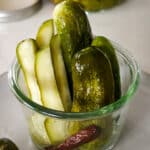Print
Easy Lacto-Fermented Dill Pickles
These easy lacto-fermented pickles recipe is vinegar-free but rich in live probiotics and enzymes and flavor.
Servings 16 servings
Ingredients
- 2 ½ lbs pickling cucumbers washed and dried
- 2-3 large grape leaves or blackcurrant leaves, oak leaves, or horseradish leaves for tannins
- 2 dried serrano peppers or 1 teaspoon crushed red pepper flakes
- 8 cloves garlic
- ½ bunch fresh dill with stalks or dill heads with stalks
- 1 tablespoon dried dill seed or dill weed
- 1 tablespoon coriander seeds
- 1 teaspoon mustard seeds
- 1 teaspoon black peppercorns
- 3 tablespoons sea salt
- water, enough to cover boiled and cooled to room temperature
Instructions
- In a half-gallon size jar, place a few leaves to the bottom and add dried pepper. Pack the cucumbers tightly on top of the leaves about ⅓ of the way.
- Add half of garlic, dill seeds, coriander seeds, mustard seeds and peppercorns. Tuck fresh dill. Pack the rest of the cucumbers, followed by remaining garlic.
- Add salt over the cucumbers. Pour enough water to fully submerge the cucumbers, leaving a 1" headspace on top.
- Place in the warmest part of your kitchen to ferment at room temperature for 1-2 weeks or until desired taste is achieved. Burp daily and turn upside down to gently shake to make sure all salt and spices is dispersed throughout.
Notes
Recipe makes 2 quarts.
Storage: After the active fermentation period is over (about 2 weeks), transfer to the refrigerator. These pickles will last up to a year and only get better with time.
Helpful Tips:
- Sanitize the jar by pouring hot water inside for a quick clean before packing the cucumbers in.
- Keep it all submerged - Make sure the brine fully covers the cucumbers, dill, and garlic. If helpful, use a glass fermentation weight.
- Burp jar daily - Open the jar to release gasses formed during fermentation. I like to burp the jar daily for at least the first week until the brine becomes cloudy.
- Taste regularly - Check the flavor after a few days or weeks, and stop fermenting when it's to your liking. It will continue to culture in the fridge but much slower.
- Pickles are soft? Make sure you're using the right salt-to-water ratio, typically about 2 tablespoons of salt per quart of water to keep the pickles crunchy. And don't forget to add those tannin-rich leaves.
- Seeing mold? If you used the proper amount of salt, it's unlikely that what you're seeing is mold as bad yeasts do not tolerate salt. If it looks like a white film developed on the surface, it's kahm yeast. Simply skim it off the top and carry on. If you see fuzzy, pink or blue growth - that's mold, and at that point, it's unsalvageable.
- Don't have tannin-rich leaves? Bay leaves can work in a pinch, though they have minimal tannin. Black and green tea also contain tannin, but they will affect the brine's flavor. If using tea, go with green tea and use just a teaspoon or two of loose leaf.
Nutrition
Calories: 14kcal | Carbohydrates: 3g | Protein: 1g | Fat: 0.3g | Saturated Fat: 0.02g | Polyunsaturated Fat: 0.04g | Monounsaturated Fat: 0.1g | Sodium: 1747mg | Potassium: 123mg | Fiber: 1g | Sugar: 1g | Vitamin A: 275IU | Vitamin C: 4mg | Calcium: 25mg | Iron: 0.4mg
